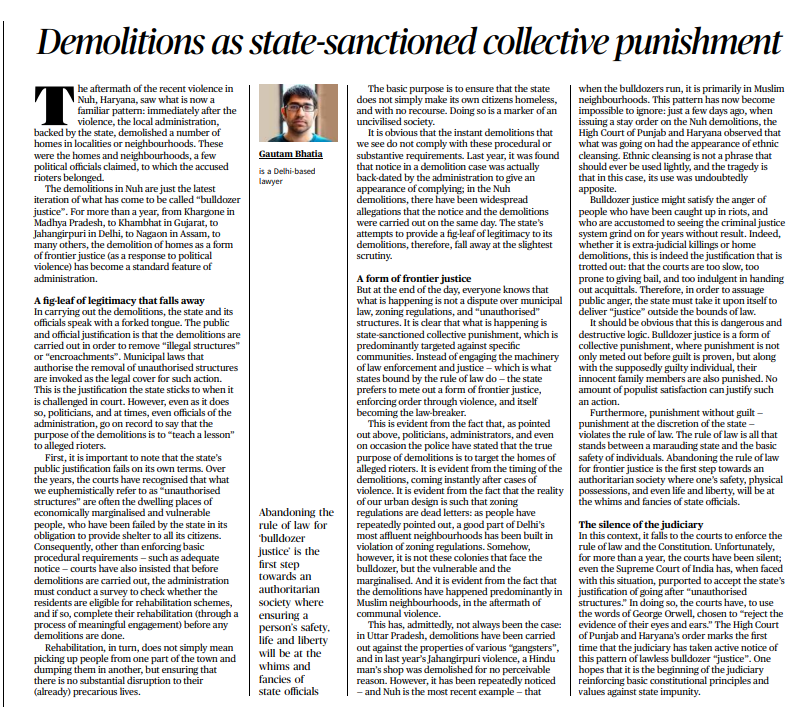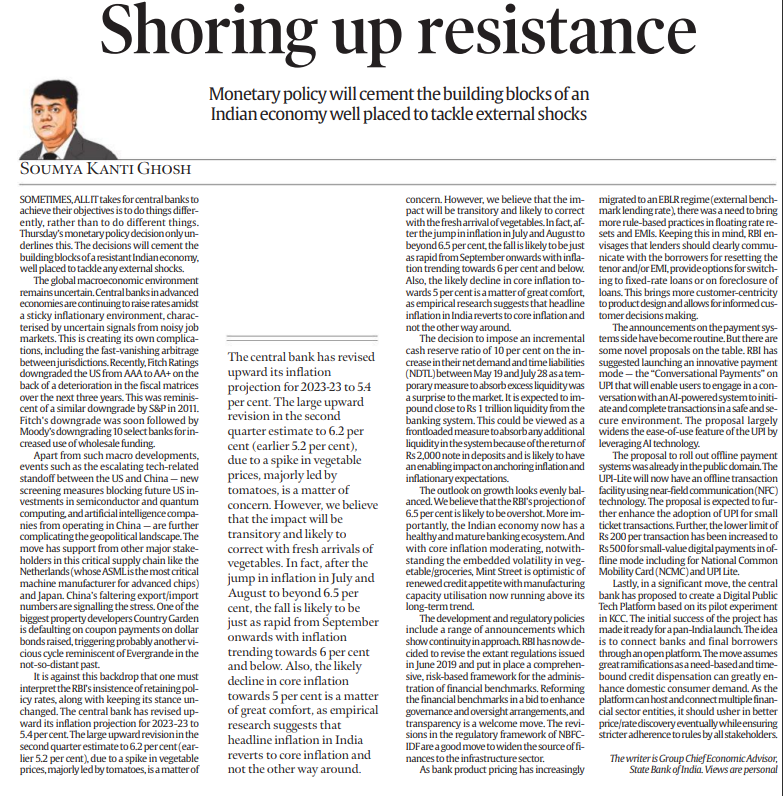Bulldozer Justice: State-Sanctioned Collective Punishment
Introduction: The Familiar Pattern of Bulldozer Justice
- The aftermath of recent violent incidents, such as the one in Nuh, Haryana, has revealed a recurring pattern known as “bulldozer justice.”
- This approach involves the immediate demolition of homes and neighborhoods linked to accused rioters by the local administration, often with state backing.
- This practice has gained momentum across various regions, notably Khargone, Khambhat, Jahangirpuri, and Nagaon, as a response to political violence.
Dual Justifications: Legal Cover and Real Intent
- The state’s official rationale for these demolitions is to eliminate “illegal structures” or “encroachments” by invoking municipal laws.
- These laws provide the legal basis for the state’s actions and serve as its defense in court.
- However, this justification contradicts politicians’ statements, which often admit that the goal is to “teach a lesson” to alleged rioters.
- This public justification collapses upon closer scrutiny, as it fails to address the marginalized and vulnerable people living in these structures who have been let down by the state’s failure to provide proper shelter.
Legal and Ethical Shortcomings
- Courts have acknowledged that these so-called “unauthorized structures” are often inhabited by economically disadvantaged individuals, necessitating a more compassionate approach.
- Legal proceedings should involve proper notice, eligibility surveys for rehabilitation, and meaningful engagement before any demolitions occur.
- The current instant demolitions often lack these essential procedural and substantive requirements, indicating a disregard for the rule of law and citizens’ welfare.
Collective Punishment in the Guise of Frontier Justice
- Beyond mere legal disputes, these actions represent state-sanctioned collective punishment aimed primarily at specific communities.
- Rather than upholding the rule of law, the state resorts to a form of frontier justice, using violence to enforce order.
- This is evident in the immediate timing of demolitions following violent incidents and the selective targeting of vulnerable communities.
- The disproportionate impact on Muslim neighborhoods after communal violence indicates a troubling pattern.
Dangers and Implications of Bulldozer Justice
- While bulldozer justice might appease public anger stemming from a slow criminal justice system, it is a dangerous and destructive approach.
- Collective punishment, even against innocent family members, violates the rule of law and undermines the foundations of a just society.
- Such actions, driven by populist sentiments, pave the way for authoritarianism and leave individuals at the mercy of arbitrary state decisions.
Role of the Judiciary: Reinforcing Constitutional Principles
- Amid this concerning trend, the judiciary’s role is crucial in upholding constitutional values and principles.
- The courts’ silence in the face of bulldozer justice has allowed these actions to persist, despite clear violations of citizens’ rights.
- The High Court of Punjab and Haryana’s recent order acknowledging the appearance of ethnic cleansing marks a significant step toward addressing this issue and reasserting the rule of law.
Conclusion: Upholding Justice and Safeguarding Democracy
- “Bulldozer justice” represents a disturbing departure from the rule of law, where punishment precedes guilt and state officials wield unchecked power.
- The ongoing pattern of demolitions underlines the need for a strong and vigilant judiciary to prevent the erosion of constitutional principles, protect individual rights, and ensure a just and democratic society.
- How would you characterize the recurring phenomenon of “bulldozer justice” as observed in various regions following episodes of political violence, and what broader implications does this practice hold for the rule of law and democratic governance?
RBI'S MONETARY POLICY DECISION AND INDIA'S RESILIENT ECONOMIC OUTLOOK
Context:
- The recent monetary policy decision by the Reserve Bank of India (RBI) emphasizes the significance of innovative approaches in achieving central bank objectives.
- The decision’s impact on inflation, liquidity management, growth projection, regulatory reforms, and digital payment innovations is analyzed.
Global Macroeconomic Environment and Central Bank Challenges:
- Advanced economies’ central banks are grappling with rising rates amidst sticky inflation and uncertain job markets.
- Fitch Ratings’ downgrade of the US and challenges in the tech-related standoff between the US and China add complexity to the global macro landscape.
RBI’s Inflationary Concerns:
- The RBI maintains policy rates and an unchanged stance, accompanied by an upward revision of the inflation projection for 2023-24 to 5.4%.
- A notable spike in second-quarter inflation (6.2%) due to vegetable prices, primarily tomatoes, raises concern.
- However, this impact is likely transitory, with expectations of inflation retreating to 6% and below by September.
Liquidity Management and Policy Measures:
- The RBI’s surprising decision to impose a 10% incremental cash reserve ratio (CRR) on net demand and time liabilities (NDTL) aims to absorb excess liquidity caused by the return of Rs 2,000 notes in deposits.
- This measure, designed to anchor inflation and inflationary expectations, could remove around Rs 1 trillion liquidity from the banking system.
Economic Growth and Banking Ecosystem:
- The outlook on growth appears balanced, with expectations of surpassing the RBI’s 6.5% projection. India’s banking ecosystem is mature and healthy, and moderating core inflation contributes to renewed credit appetite.
- Regulatory policies support this, with reforms in financial benchmarks administration and widening the source of infrastructure sector finances.
Customer-Centric Banking and Payment Innovations:
- RBI’s focus on customer-centricity is evident in efforts to enhance communication between lenders and borrowers for rate resets and EMIs.
- Additionally, the introduction of “Conversational Payments” on UPI, utilizing AI-powered systems for secure transactions, underscores the central bank’s commitment to innovation in digital payments.
Offline Payment Systems and Digital Public Tech Platform:
- The proposal to launch UPI-Lite with offline transaction capabilities using NFC technology aims to boost UPI adoption for small transactions.
- Moreover, the RBI’s plan to establish a Digital Public Tech Platform based on its successful KCC pilot experiment could significantly impact credit dispensation, promoting domestic consumer demand and enhancing rate discovery.
Conclusion:
- The RBI’s recent monetary policy decision aligns with the principle that innovative approaches can achieve central bank objectives.
- Against the backdrop of global uncertainties and geopolitical complexities, India’s resilient economy is well-positioned to address external shocks.
- The decision’s multifaceted impact on inflation, liquidity, growth, regulatory reforms, and digital innovations underscores the central bank’s proactive stance in ensuring economic stability and progress.
- How does the recent monetary policy decision by the Reserve Bank of India reflect the importance of innovative approaches in achieving central bank objectives, particularly in the context of global macroeconomic uncertainties?
Q. In light of the outlook on economic growth, how does the current state of India’s banking ecosystem contribute to the country’s resilience? What are the regulatory reforms introduced by the RBI to support this ecosystem?



